Standing with Saguaros
Intimate Theatre and Intimate Environmentalism
Some years ago I stood with a saguaro cactus for an hour. As a dancer, I was trying to figure out how to make a duet with the cactus, icon of the desert Southwest, where I live.
For all its majesty, the saguaro is a plant that does not want to be touched. So instead of wrapping my arms around the saguaro and leaning into it, I simply stood next to one at sunset for sixty minutes. As the light shifted, bees turned to bats, nighthawks appeared, wind whispered through the spines. I swayed a little. So did the saguaro.
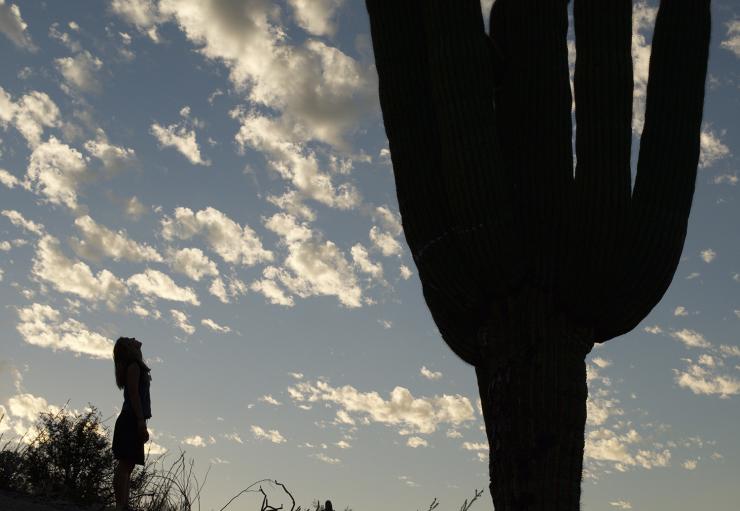
I wondered later if what I had done constituted a performance. Is it a performance if no human audience witnesses it? Was I the audience? Were the desert plants and wildlife? More broadly, what do performances with, about, and for other species reveal about how we view those species? About how we view ourselves? How might such performances expand our notions of community, inspiring us to be better stewards of where we live?
I am exploring these questions anew as the director of an expanded version of that early experiment. Standing with Saguaros is a three-act engagement that explores the many relationships of the saguaro within the Sonoran Desert ecosystem and beyond. Presented by Borderlands Theater in partnership with Saguaro National Park, it is part of the “Imagine Your Parks” initiative of the National Endowment for the Arts in celebration of the National Park Service Centennial.
I’ll report on acts two and three of the project in subsequent blog posts, but here I highlight discoveries I’ve made in act one, a six-week public campaign called #IStandwithSaguaros. Part theatre, part meditative activity, the campaign invites people to Saguaro National Park to stand with a saguaro, as I did, as a way of befriending, supporting, and connecting with the species. Afterwards, people post their discoveries along with “saguaro selfies” on social media with the identifier #IStandwithSaguaros.
Act one of Standing with Saguaros offers an intimate performance that needs no script or choreography, no language or music. The performance begins when we start paying attention to a single saguaro. That kind of attention invites stillness, empathy, and intimacy. Those qualities have the potential to expand into reverence for saguaros as a species and for the desert at large.
While these stands are decidedly multi-layered experiences, I’ve come to think of them as individualized and intimate performances. To date, over 215 people have stood with saguaros in the national park and in urban parks or patches of desert. Here is what I’ve been learning from them:
1. Being still and silent with another species over time invites deep observation, listening, and friendship.
Admittedly in the world of durational performance, one hour isn’t really very long. And yet when we stand still for an hour with a saguaro cactus in the desert, we are given an experience we might miss if we simply passed by. Many note how generous the saguaros are, offering beauty, blooms, and fruit to countless species, including us. What can we possibly give back but our time and attention? Indeed, over the course of an hour, many report coming to see the particular saguaro they stood with as “my saguaro,” language that reflects not a sense of ownership, but a sense of tender stewardship, as in “my friend.”
My new friend, the saguaro, had five large arms… -Jill, 55
We learned that saguaros can touch the sky. We learned that saguaros are good for making friends. –Jen, 40, and daughter Eva, 3
I noticed the saguaro had dead skin, when they die they turn into skeletons. I heard wind, plants moving. It taught me how to move. I learned saguaros can be nice. –K., 13
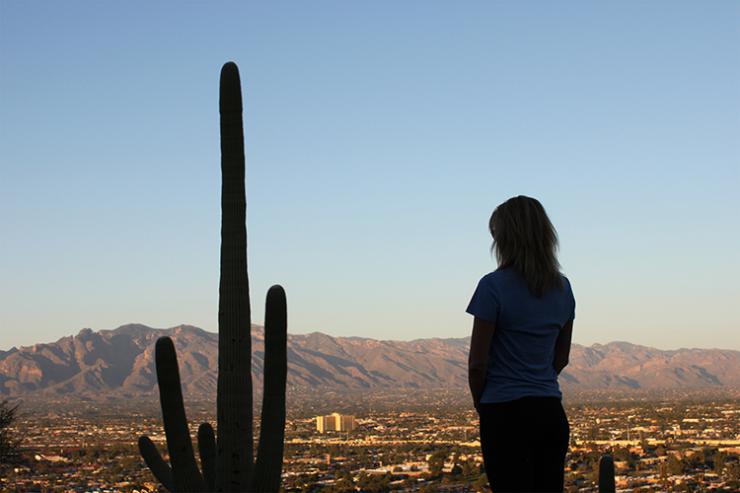
2. Finding commonalities with another species can help dismantle the hierarchy that often places humans above other species. For the Tohono O’odham, indigenous residents of the Sonoran Desert, the saguaros are considered people. Indeed, many others easily find human qualities in saguaro arms and gestures. Sometimes their holes and scars suggest faces and countenances.
I noticed their beautiful shapes, which echoed both male and female body parts. I like the toddlers and teenagers, the seemed to have a different energy about them. I also spent time with a “retired” saguaro that was sporting only ribs. -Barbara, 60+
I notice that some cactus are alone and I named some names. And I feel the cactus is talking to me. I hear some tunes of the spikes. -H., 13
My saguaro was worn down like a person who has known hardship. It sang like a rainstick. -Lisa, 33
When we stand with the saguaro, we join it, on its turf, on its own terms. Some people report curiosity about what their saguaro sees or feels. This kind of identification with “other,” or putting ourselves in another’s “shoes,” is a necessary component of empathy.
Similarly, when we frame these experiences as performances, we invite new definitions of “audience” and “performer.” Are we watching the saguaro or is the saguaro watching us? Perhaps these duets serve to break what Una Chaudhuri calls “the fifth wall of anthropocentrism.”
When we allow ourselves to consider the possibility that the saguaro might sense something about us—that it is witnessing us, just as we witness it—we make room for a more equal relationship. The hierarchy that places humans above other species because of our supposed superior ways of knowing has the potential to fall away and we can stand together, in place, as equals.
3. Intimacy helps us understand ourselves, another, and our shared place within the local landscape.
In 1972, the “Big Blue Marble” photograph of Earth taken from space helped incite the modern environmental movement by giving us a new perspective of our planet. But as writer and climate justice activist Naomi Klein suggests, it may have cast too distant a view. What we need now, Klein writes, are “intensely local” views:
“Climate change is place-based, and we are everywhere at once. The problem is not just that we are moving too quickly. It is also that the terrain on which the changes are taking place is intensely local: an early blooming of a particular flower, an unusually thin layer of ice on a lake, the late arrival of a migratory bird. Noticing those kinds of subtle changes requires an intimate connection to a specific ecosystem. That kind of communion happens only when we know a place deeply, not just as scenery but also as sustenance, and when local knowledge is passed on with a sense of sacred trust from one generation to the next.” The Guardian, April 23, 2014.
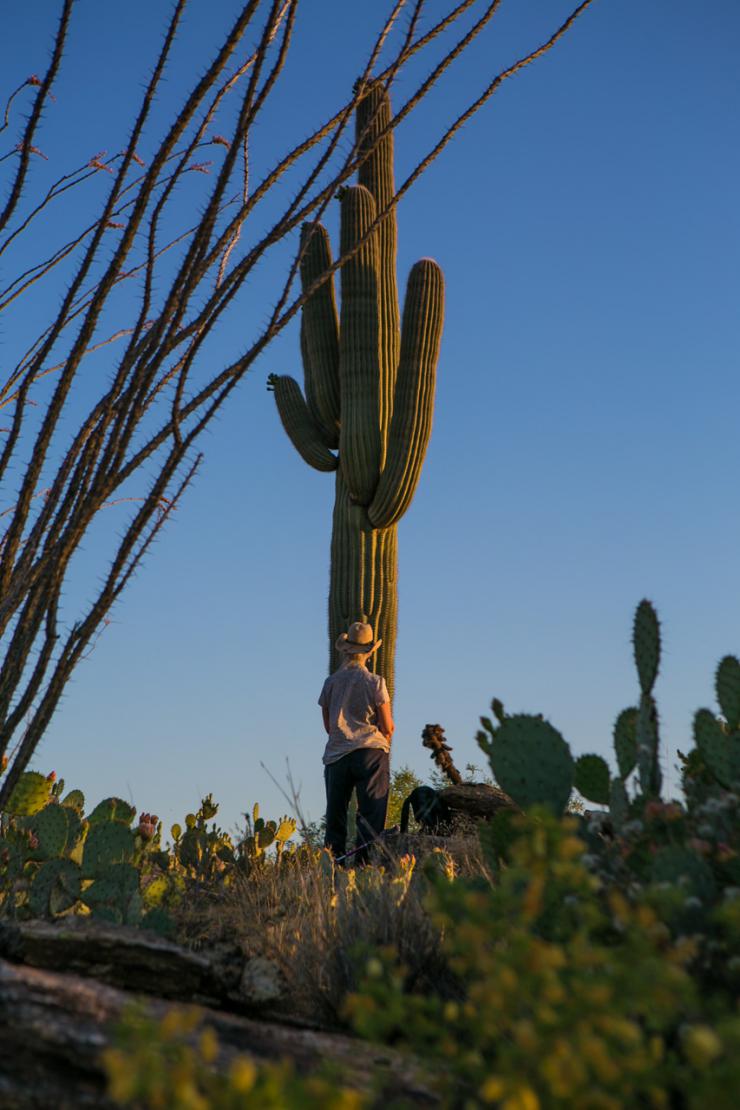
Standing with saguaros invites an “intimate environmentalism,” one that helps us expand our definition of community to include plant and animal species. The experience is intensely local, different than standing with, say, a redwood or a yellow cedar tree.
People notice tiny details about “their” cactus—bird holes, spider webs, scratches, scars. People notice other species around them—barrel and cholla cactus, mesquite and palo verde trees, white-winged doves, flickers, canyon wrens, jackrabbits. People notice the wind, the clouds, the sun. Eventually the entire desert ecosystem comes into view—a moving, living, breathing set. And within that ecosystem, part of it, are they themselves, human beings.
I loved the dramatic setting and seeing the scale of my small humanness against the largeness of nature. [I had] the sense of being OTHER in this giant mega-guild of successful organisms that "accept" me but have absolutely no need for me, though I feel welcomed and humbled… -Jill, 55
I feel like I noticed more and more and more and more, the longer I was there. Heard wind and wrens, felt bigger, larger, more abundance and felt … that I was in the presence of knowledge. –Tyler, 37
Act one of Standing with Saguaros offers an intimate performance that needs no script or choreography, no language or music. The performance begins when we start paying attention to a single saguaro. That kind of attention invites stillness, empathy, and intimacy. Those qualities have the potential to expand into reverence for saguaros as a species and for the desert at large. As one park ranger said, “The saguaro is the icon of the Sonoran Desert, so if you stand with the saguaro, then you stand with the Sonoran Desert.”
As intimate theatre and intimate environmentalism, this kind of experience is free and accessible to anyone who lives near a saguaro cactus. Of course, the experience is not limited to saguaros or desert species. We can tune in to all forms of life, anywhere we are, offering our time and our attention with silence and stillness. In return, we’ll get a better understanding of ourselves and the species with which we share the planet. For this, from the saguaros, we’ll likely get a standing ovation, too.

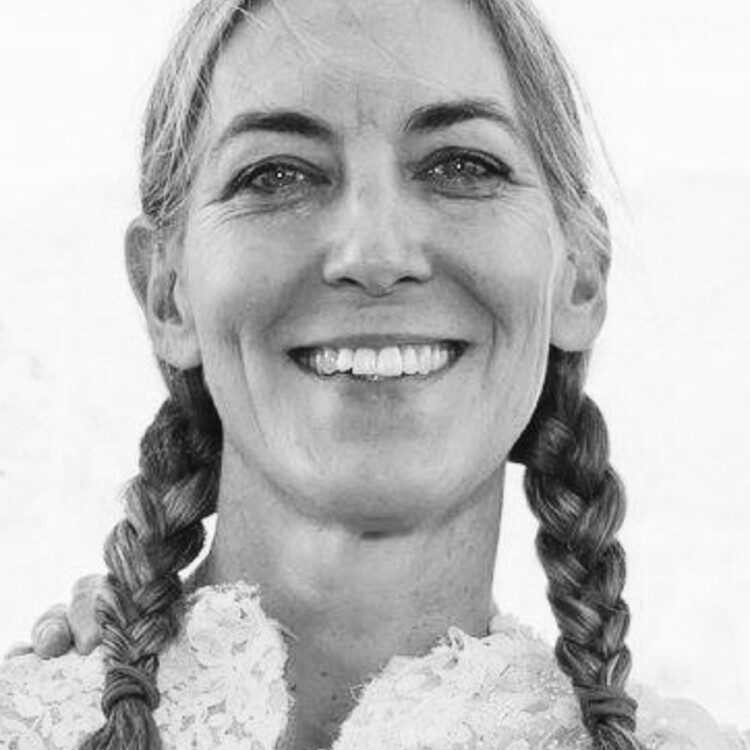
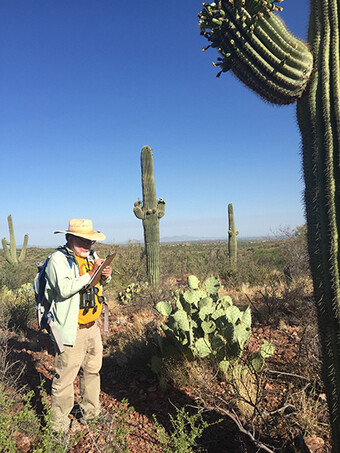






Comments
The article is just the start of the conversation—we want to know what you think about this subject, too! HowlRound is a space for knowledge-sharing, and we welcome spirited, thoughtful, and on-topic dialogue. Find our full comments policy here
Such a wonderful project! Thank you for writing about it. If I were anywhere near a saguaros, I would definitely stand with it.
Thanks Chantal! I've loved learning, too, about your trip with Island Institute in AK. I was an artist-in-residence with them last fall and loved following the ferry tour! Hope our paths cross soon.
Oh, small world! The ferry tour was wonderful. And I too hope our paths cross soon.
Thanks @teresa_marrero:disqus.
I really love this project, particularly the sharing through this platform people's insights through their standing meditations near the saguaros. The awareness that we human beings may be accepted but not necessary within an ecosystem is a priceless lesson in humility. In a world that venerates the performative, 'acting' I, how refreshing to experience the stillness of the we. Now, if the saguaros could only talk.... surely they do, and you are listening and allowing us listen too. In recognition that HowlRound offers us a way to communicate that stands unique among the arts, maybe it's a saguaro too that galvanizes us around it.